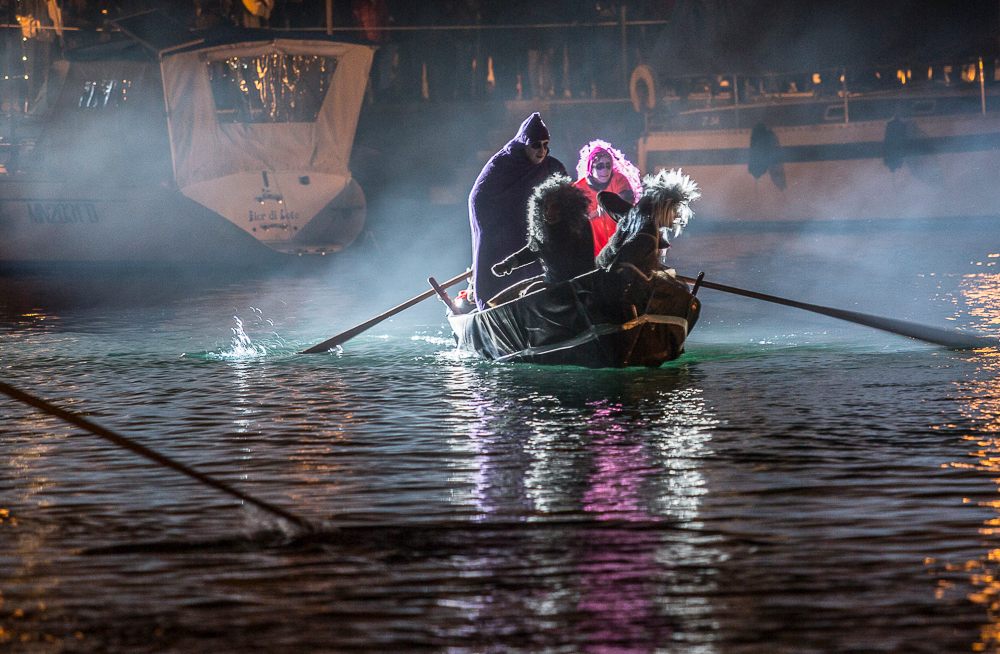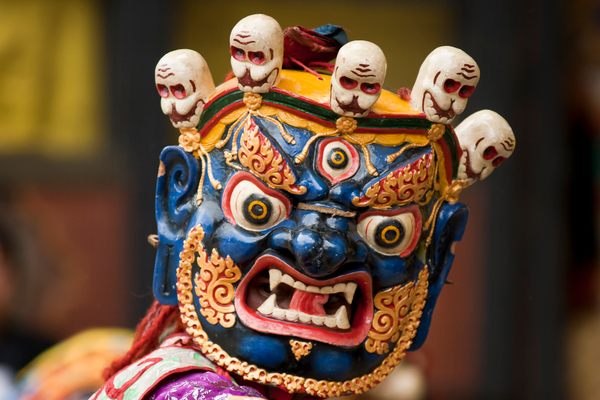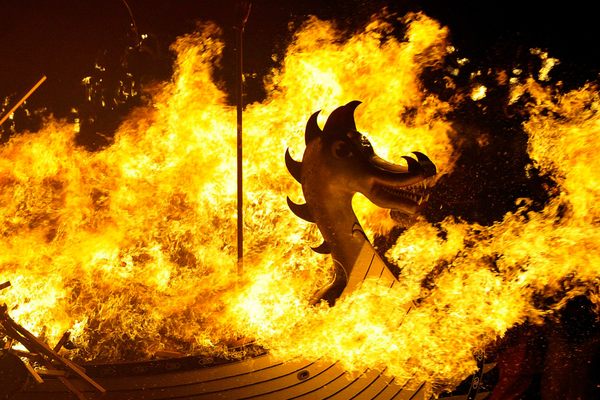In This Seaside Town, the New Year Brings a Battle With the ‘Witches of the Sea’
The local Epiphany celebration of Grado, Italy, is inspired by a mysterious band of 16th-century pirates.
Each holiday season, children around Italy eagerly await the Feast of the Epiphany, celebrated on January 6. That’s when the Befana, an old lady riding a broomstick, fills up stockings with candy (for well-behaved children) or charcoal (for naughty ones). Originally a religious festival marking the visit of the magi to baby Jesus, like many Christian celebrations, the Epiphany got mixed up with local folklore. Hence the Befana.
But children in the northeastern town of Grado, have their own dramatic, even frightening version to get excited about: the Varvuole, the witches that come from the sea.
On January 5, locals gather at Porto Mandracchio, the coastal town’s historic harbor, and anxiously scan the horizon. It’s common for dense fog banks to form over the Adriatic Sea at that time of year, adding to the atmosphere. Through loudspeakers on the marina docks, a solemn voice intones: “They are about to come.” Men wearing hoods start beating drums. A few minutes later, 10 rowboats appear on the dark horizon and slowly make their way toward to shore. Stage lights illuminate their approach, revealing ghost-like creatures on board.

Looking like a mix between Edward Scissorhands and a zombi-fied French aristocrat, the Varvuole disembark and make their way into the streets of Grado. They scream and hiss and dance. Children start running; the Varvuole are on the hunt.
Then a battle commences. A group of women wearing traditional dresses, armed with garlic and wooden crosses, goes after the sea witches. They fight and dance until the Varvuole are defeated.
Each year, thousands travel to Grado from the surrounding region of Friuli Venezia Giulia to witness the ancient ritual. Like many legends, the Varvuole tradition has roots in both myth and reality. Celebrations centered around witch-like figures such as the Befana are found across Italy, and usually arise from pre-Christian winter solstice rituals featuring pagan deities such as the ancient Roman goddess Strenua.

In Grado, the archetype of the “winter witch” is intertwined with a real historical threat: pirate attacks by the Uskok people. A historically overlooked population, the Uskoks were displaced people from the Balkans who, for around 100 years, influenced life all around the Adriatic.
“After the 1389 Battle of Kosovo, the Ottomans effectively took over the Balkans for nearly five centuries,” says Stevka Smitran, who studies Balkan culture and literature at the University of Teramo, and wrote one of the few academic books on the Uskok people. “People of various ethnicities had to flee and moved north toward the Adriatic Sea.”
That’s when the Uskok tribe was formed. The word uskok (uskoc in Croatian) originally means something like “jumping backward,” and was used to refer to people fleeing the Balkans to escape Ottoman rule. As Smitran explains, the Uskoks were a mixed group of ethnic Serbs, Croats, and Bosnians. They spoke multiple languages, mainly Latin and Serbian. They were Catholic or Greek Orthodox. At their height, they numbered no more than a few thousand. Yet, for a period of 100 years or so, the Uskoks, based mostly in parts of modern-day Croatia such as Klis and Senj, were a key force in Adriatic politics and life.

“During the 15th and 16th centuries the Adriatic Sea was dominated by three main powers,” Smitran says, “the Republic of Venice, the Hapsburgs, and the Ottomans.” The Uskoks became the fourth. At first, they mostly worked as paid soldiers for the Hapsburg crown, which had hired them to contain Ottoman advances. After a while, perhaps because of delays in payment, they turned to other sources of income—including banditry and piracy.
The Uskoks raided commercial and military ships, mostly belonging to the Venetian and Ottoman fleets. “They were famous for raiding big ships from smaller boats,” Smitran says, “and for their unusual clothes.” The typical Uskok outfit consisted in a long vest, usually with studs, and busbies (furry military hats from what is now Hungary) with feathers. It is possible to see how this distinctive fashion sense inspired the concept of “sea witches” that evolved into the myth of the Varvuole.

Though they’re historically overlooked, the Uskoks left a profound mark on Adriatic folklore. Smitran found that they were the most popular subject of poems written in the Balkans during the 15th and 16th centuries. “Poets wrote about the Uskoks more than they wrote about love or death,” she says. While poets based in modern-day Croatia described the Uskoks as brave heroes, authors in other parts of the Adriatic saw them as dangerous and ruthless pirates. Grado, which at the time was under Venetian jurisdiction, would have had the latter impression. Oral histories about dangerous, unusually dressed Uskoks coming from the Croatian coast were passed on from one generation to the next. “I think there is a real connection between the Uskoks and traditions like the Varvuole,” Smitran says. “They posed a real danger for nearly a century.”
Today, the Varvuole celebration in Grado reenacts some of the old fears about pirate attacks. “The event is structured in three main parts,” says Luisa Venier, an elementary school teacher involved with the event organization. The first part, she explains, is the arrival of the witches on batele, the typical, flat-bottomed rowing boats of Grado. “That is perhaps the most dramatic moment of the day,” she says. “There is a crescendo of drums that builds a lot of anticipation.” A loud voice prepares the public for their arrival. “I hear them coming, you better hide.” People start to squint out to sea. “They come from the sea,” the voice adds. “And they are fearless.” Slowly but steadily, the first few boats begin to appear at the harbor entrance. Rowed by figures in dark hoods and lit only by oil lamps, they look like smaller versions of the ghost vessel Flying Dutchman. The shape of Grado’s harbor, with a long Y-shaped canal, allows for a slow, dramatic entrance. The fog—or, failing that, a fog machine—adds to the ambience. As the boats approach, the voice warns children to find shelter. “The Varvuole are back!”

The second part of the event sees the fight between the Varvuole and local women, called Populane. After the Varvuole disembark, they run around the streets of Grado making terrifying sounds and frightening poses. The Populane pursue—wielding the crosses and garlic familiar today from vampire tales—and shout words in local dialect believed to weaken the witches. The town band accompanies with emphatic drumming. The zombie-like poses and banshee-like screams of the Varvuole are something straight out of a horror movie. “During this part some children get actually scared and run away,” Venier says. Indeed, she explains, taking part in this tradition can help children learn about fear. “I am an elementary school teacher and use myths as an education tool,” she says. “In this case, children learn to process their fear by seeing that danger can be managed.”
The climax of the fight takes place on a stage, with choreographed dancing. “In recent years we have set the stage on a dam with the sea as a backdrop,” says Selene Lupieri, owner of local dance school Avenal, which, for the past few years, has arranged the choreography. “It makes for a perfect setting to tell the story of sea witches.” The stage is the best place to admire the Varvuole costumes: faces painted in white with dark circles around their eyes, long black dresses covered with damaged fishing nets, and, most impressively, gray-and-white Louis XIV–style wigs. The score is from composers such as Igor Stravinsky, Modest Mussorgsky, Ezio Bosso, or Jocelyn Pook. Sometimes, the dance ends with a group of Varvuole encircling a handful of terrified kids.

The third and final act of the event takes place when the Varvuole finally surrender to the Populane in the square of Piazza Biagio Marin, in front of a 16th-century building called Casa della Musica (House of Music). From the windows of the building, the Populane proclaim their victory. “This part is where children learn that danger can be managed,” Venier says. “It’s a triumph of the city against the witches.”
Each year, groups of volunteers start preparing for the tradition months in advance. Local women, mostly dance students, sign up to play the Varvuole. The municipal government handles the sound equipment and stages. Even the coast guard plays a big role, making sure that rowboats can moor safely on the often icy docks.
The months of preparation and thousands of attendees speak to the ongoing relevance of this ancient ritual. Even in the absence of pirate attacks, the Varvuole still embody all the wider fears about the sea, Venier says. “Events like high tide surge that happen each winter remind us of the very real danger of the sea in winter,” she explains. “This is not just fun or entertainment. It’s a way to process a collective fear.”

























Follow us on Twitter to get the latest on the world's hidden wonders.
Like us on Facebook to get the latest on the world's hidden wonders.
Follow us on Twitter Like us on Facebook